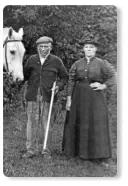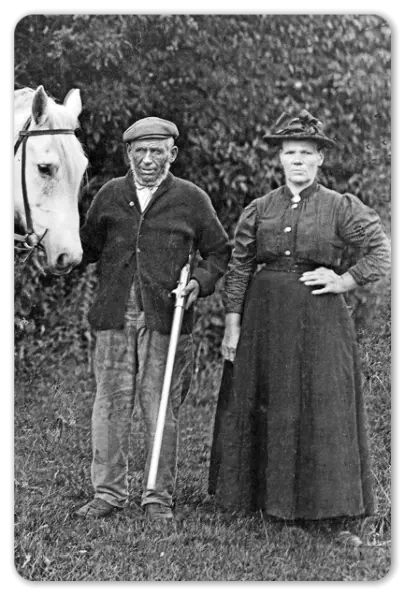To give the background to the story, I should explain that after my grandfather, who was
landlord of the Noel Arms, died in 1898 my grandmother was obliged to sell up and leave
the pub as, in those days, a woman was not allowed to hold a licence. Having four young
children to care for she obviously had to find other means of earning a living for them.
As well as being licensee, grandfather also held the tenancy of Yew Tree Farm which he had
taken over from his father on the latter's death in 1879. Grandmother persuaded the Estate
to transfer the tenancy to her, in trust for her son and this was duly done. However,
another complication ensued. As landlord, my grandfather obviously had to live on the
premises and, as a result, Yew Tree Farmhouse became vacant upon my great grandfather's
death and the property was consequently let away on a private lease. This was common
practice at that time since the majority of housing was either rented or leased and the Estate, having to bare
the cost of maintenance and repairs was not prepared to leave a house unoccupied. As the lease of Yew Tree
House did not expire until the autumn of 1900, Grandmother had to find accommodation until the farm house
became vacant.
Yew Tree Farm had two sets of farm buildings. One was situated at the top of the village and comprised the
farmhouse and buildings on the north side of what is now Burley Road with further cattle yards and a paddock
on the south side where the present school is built. The second set of premises were situated right at the
bottom, or eastern end of the village and consisted of a barn, stabling, cattle yards and other buildings
together with a grass paddock of about two acres. The buildings adjoined Manor Lane, as it is now called, and
the main entrance was from that road. Of course, having four children to care for, Grandmother was not able
to take any part in the work of the farm but she was fortunate in having the services of three good men, one of
whom had acted as farm foreman for my grandfather. His name was Peake Sewell and although, as was
common at that time, he had received little formal education he had a keen natural intelligence and was fully
experienced in the day to day running of the farm. He, therefore, undertook to work the farm, leaving
Grandmother to deal with the business side. Conditions in farming were just beginning to improve again after
the appalling depression of the 1870s and '80s and, although money was still tight, prices were improving and
affairs began to settle down again after all the upheavals of the previous two or three years.
In the autumn of 1900 Grandmother was able to move into Yew Tree House. My father was away at school and
his two elder sisters attended a private school in Oakham, the youngest sister still being at home. Although
milk was not produced for sale, three milking cows were kept, along with other livestock, to provide milk for the
house and the men; any surplus being set for the cream to rise. This was then skimmed off and made into
butter; the skimmed milk being fed to the pigs. The cows were kept in an open shed at the Bottom Yard and it
was Peake's last job each night to carry the remainder of the milk up to Yew Tree House when he went to
report on the day's work and discuss the schedule for the following day.



Langham Village History Group ~ © 1996 - 2025
The Milk Theft (1) - Don Mantle




I should explain that after my grandfather, who was landlord of the Noel Arms, died in 1898
my grandmother was obliged to sell up and leave the pub as, in those days, a woman was
not allowed to hold a licence. Having four young children to care for she obviously had to
find other means of earning a living for them. As well as being licensee, grandfather also
held the tenancy of Yew Tree Farm which he had taken over from his father on the latter's
death in 1879. Grandmother persuaded the Estate to transfer the tenancy to her, in trust
for her son and this was duly done. However, another complication ensued. As landlord,
my grandfather obviously had to live on the premises and, as a result, Yew Tree Farmhouse
became vacant upon my great grandfather's death and the property was consequently let
away on a private lease. This was common practice at that time since the majority of housing was either
rented or leased and the Estate, having to bare the cost of maintenance and repairs was not prepared to leave
a house unoccupied. As the lease of Yew Tree House did not expire until the autumn of 1900, Grandmother
had to find accommodation until the farm house became vacant.
Yew Tree Farm had two sets of farm buildings. One was situated at the top of the village and comprised the
farmhouse and buildings on the north side of what is now Burley Road with further cattle yards and a paddock
on the south side where the present school is built. The second set of premises were situated right at the
bottom, or eastern end of the village and consisted of a barn, stabling, cattle yards and other buildings
together with a grass paddock of about two acres. The buildings adjoined Manor Lane, as it is now called, and
the main entrance was from that road. Of course, having four children to care for, Grandmother was not able
to take any part in the work of the farm but she was fortunate in having the services of three good men, one of
whom had acted as farm foreman for my grandfather. His name was Peake Sewell and although, as was
common at that time, he had received little formal education he had a keen natural intelligence and was fully
experienced in the day to day running of the farm. He, therefore, undertook to work the farm, leaving
Grandmother to deal with the business side. Conditions in farming were just beginning to improve again after
the appalling depression of the 1870s and '80s and, although money was still tight, prices were improving and
affairs began to settle down again after all the upheavals of the previous two or three years.
In the autumn of 1900 Grandmother was able to move into Yew Tree House. My father was away at school and
his two elder sisters attended a private school in Oakham, the youngest sister still being at home. Although
milk was not produced for sale, three milking cows were kept, along with other livestock, to provide milk for the
house and the men; any surplus being set for the cream to rise. This was then skimmed off and made into
butter; the skimmed milk being fed to the pigs. The cows were kept in an open shed at the Bottom Yard and it
was Peake's last job each night to carry the remainder of the milk up to Yew Tree House when he went to
report on the day's work and discuss the schedule for the following day.



Langham Village History Group ~ © 1996 - 2025















![Close [x]](index_htm_files/close.png)










































